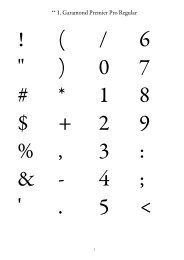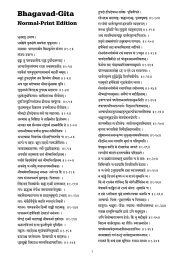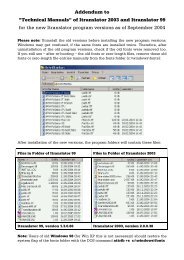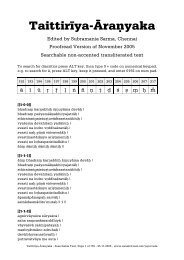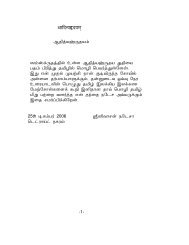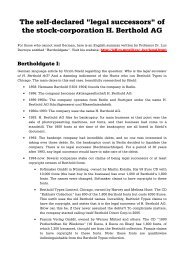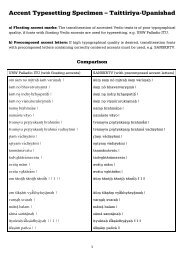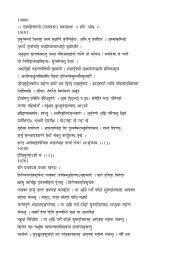[[1-1-1]] [[Book-Chapter-Paragraph]] - Sanskrit Web
[[1-1-1]] [[Book-Chapter-Paragraph]] - Sanskrit Web
[[1-1-1]] [[Book-Chapter-Paragraph]] - Sanskrit Web
You also want an ePaper? Increase the reach of your titles
YUMPU automatically turns print PDFs into web optimized ePapers that Google loves.
who knowing thus perform the year (sacrifice) are prosperous. Therefore a hornless cow has<br />
pleasure during the two months of the rainy season, for that is won for it by the Sattra. Therefore<br />
whatever is done in the house of one who performs for a year (a Sattra), that is done completely,<br />
successfully, and adequately. Those who perform the year (Sattra) are swimming on the ocean. He<br />
who does not see the further bank of the ocean cannot get out from it. The ocean is the year [2]. Its<br />
further banks are the two Atiratras. Those who knowing thus perform the year (Sattra) reach the end<br />
without injury. The former Atiratra is this (earth), the latter is yonder (sky); the former is mind, the<br />
latter speech; the former expiration, the latter inspiration; the former the commencement, the latter<br />
the end. The Atiratra is a Jyotistoma, of Vaiçvanara; verily they put light before them, to reveal the<br />
world of heaven. There is a fore offering, accompanied by the Caturvinça Stoma. The year has<br />
twenty-four half-months [3]; verily as they go on they find support in the year. There are three<br />
hundred and sixty Stotriyas; so many are the nights of the year; verily they attain both forms of the<br />
year.<br />
They perform (the rites of) the next days for rest, for safety. There are six-day periods. The year has<br />
six seasons; verily they find support in the seasons, the year. The Go and the Ayus (Stomas) are the<br />
Stomas in the middle; verily they place a pair in the middle of the year [4] for procreation. On either<br />
side there is the Jyotistoma. It is the releasing; verily the metres are released; verily also they go to<br />
the world of heaven with the six-day (rite) which has a Jyotistoma on either side. The theologians<br />
say, 'They sit; by what path do they go?' One should reply,' By the path that leads to the gods. The<br />
path that leads to the gods is the metres, the Gayatri, Tristubh, and Jagati. The Gayatri is the<br />
Jyotistoma, the Tristubh, the Gostoma, the Jagati the Ayustoma. In that there are these Stomas, so<br />
do they go by the path that leads to the gods [5]. There is used the same Saman. The Saman is the<br />
world of the gods; verily they leave not the world of the gods. There are used various verses. The<br />
verses are the world of man; verily they keep mounting one world of gods after another from the<br />
world of men. There is the Brahman's Saman as the Abhivarta to win the world of heaven. There is<br />
the Abhijit (day) for the gaining of the world of heaven. There is the Viçvajit (day) for the gaining<br />
of all. Month by month they perform the Prsthas, month by month the Atigrahyas are drawn; verily<br />
in each month they place strength, for the support of the months. They perform the Prsthas in the<br />
latter part of the month. Therefore it is on the top that the plants bear fruit.<br />
[[7-5-2]]<br />
The cows performed that Sattra, being hornless and desiring to obtain horns. For ten months they<br />
performed it, and then horns appeared. They said, 'We have gained (them), let us cease (the rite), for<br />
we have attained the desire for the sake of which we began (the rite).' But others said, either half of<br />
them or as many as might be the case, 'Let us perform (the rite) for these months, the eleventh and<br />
the twelfth, and when we have made up the year, let us cease' [1]. In their case their horns grew in<br />
the twelfth month. Whether by faith, or by lack of faith-that is, those which have no horns-both<br />
indeed were prosperous, those which gained horns and those which won strength. He who ceases<br />
after ten months is prosperous, and he who ceases after twelve also, if he knows thus. They go by<br />
their feet, and he who goes by his foot attains (what he seeks). The Ayana is successful, and<br />
therefore is it productive of cows.<br />
[[7-5-3]]<br />
They perform the Prahas in the first month, they perform them in the middle month, they perform<br />
them in the last month. They say, 'In the case of a cow which they milk thrice a day, she yields<br />
sparingly at the latter two milkings; how then can she be milked who is twelve times milked?'<br />
Having made up the year, they should perform the Prsthas once in the last month; verily the<br />
sacrificers win the sacrifice and cattle. It is an ocean [1] without a near or a further shore that they<br />
enter upon who perform the year (rite). If they employ the Brhat and the Rathantara Samans, it<br />
would be as if they were to provide a boat in the middle of the ocean. Going continuously with the<br />
Brhat and the Rathantara they obtain support. The union is milked for all desires; thus the<br />
sacrificers obtain all desires.<br />
Keith: Taittiriya-Samhita, Translation - Page 333 of 341


![[[1-1-1]] [[Book-Chapter-Paragraph]] - Sanskrit Web](https://img.yumpu.com/25993632/333/500x640/1-1-1-book-chapter-paragraph-sanskrit-web.jpg)



